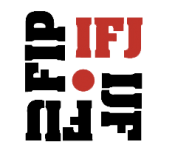Gender
Through an array of women journalists’ views and perspectives on the sexual harassment, we look at the impact of the international #MeToo movement on debate and awareness in media and media workplaces in South Asia.
Women journalists in South Asia are no longer willing to accept sexual harassment as part of the job. On April 17, 2018, the Governor of the south Indian state of Tamil Nadu reached out and patted a senior journalist on her cheek when she asked a question at a press conference, ironically about sexual harassment at the university (of which the Governor is the ex-officio Chancellor). When she took to Twitter, strongly condemning the patronising act of touching her without her consent, Lakshmi Subramaniam, senior correspondent with The Week, was signalling a notable shift in the response to sexual harassment. Her refusal to sweep sexual harassment under the carpet, garnered swift support from several organisations who stood in solidarity with her.
Soon, social media was abuzz with condemnation of the Governor’s act. The overwhelming reaction against a powerful man misusing his position and public office, represents the beginnings of change in the culture of trivialising sexual harassment. The Governor was forced to tender a written apology, though the apology contained the justification that he “appreciated” her question and patted her cheek considering her to be “like my granddaughter”. Women journalists were having none of the standard family analogies and pointed out that the Governor’s act comes under the purview of Tamil Nadu Prohibition of Harassment of Women Act, 1998 as well as the central law against sexual harassment.
The overwhelming reaction against a powerful man misusing his position and public office, represents the beginnings of change in the culture of trivialising sexual harassment.
Ripples from the revelations of sexual harassment in the entertainment industry in the US reached South Asian shores in October 2017. The allegations against media mogul Harvey Weinstein, dating back several decades, revealed just how pervasive the problem was. Scores of women – today successful, well-known personalities from the film industry came out and declared, #MeToo, sharing painful personal stories of exploitation and misuse of power. At around the same time when the #MeToo hashtag was going viral, revelations of sexual harassment in the academia, mainly in South Asian studies departments in the US, and universities across India, naming a list of men whom students and colleagues accused of sexual harassment had significant repercussions. The crowd-sourced Google document soon began running into pages, as more and more women said #MeToo. Controversial though it was, the naming and shaming strategy was a reflection of the frustration with laws and the inadequacy of due process, in situations where the pursuit of justice is so heavily laden against women.
Laws certainly exist. In addition to criminal provisions, three countries in the region have specific civil laws to combat sexual harassment at the workplace: India’s Sexual Harassment of Women at Workplace (Prevention and Redressal) Act, 2013, which replaced the 1997 Vishakha Guidelines on workplace harassment; Pakistan’s Protection Against Harassment of Women at the Workplace Act, 2010 and Nepal’s Sexual Harassment at Workplace Prevention Act, 2015. While criminal laws against sexual harassment already existed in all these countries, the specific nature of workplace harassment, with rigid office hierarchies and control by mostly-male bosses over assignments, promotions and leave, needed to be tackled through different means. Each of these laws provides for redressal mechanisms within the workplace – complaints committees, inquiries and disciplinary action. They also provide for compensation, counselling and trauma leave, in recognition of the toll that sexual harassment can take on a complainant.
Yet, these laws have not necessarily made workplaces less hostile and conducive for women journalists. It is clear that the law and redressal mechanisms can only be made to work with vigilant and proactive staff and their associations and unions. The all-pervasive belittling of women and the resultant hostile workplaces are almost a norm in small towns and the non-English press, where conversations around sexual harassment are yet to be heard, and redressal mechanisms yet to emerge. Marginalisation in other spheres – caste, class, ethnicity or region – add to the possibilities of being subjected to sexual harassment, with no recourse.
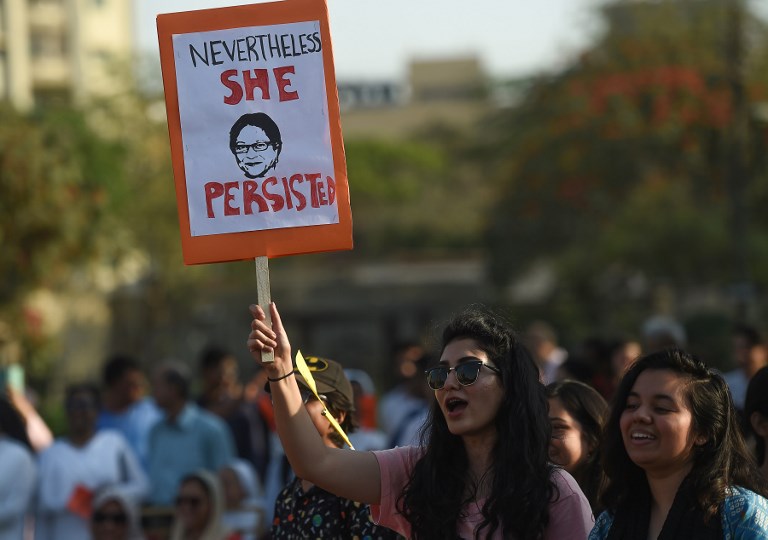
Pakistani civil society activists carry placards as the march during a rally to mark International Women's Day in Karachi on March 8, 2018. / AFP PHOTO / ASIF HASSAN
The male entitlement that defines most workspaces pervades even the emerging world of Artificial Intelligence. “I’d blush if I could”, “If you insist” “Now now!” are some of the coy and suggestive responses of a female assistant when she is sexually harassed. Except that this is Siri, Apple’s ‘virtual assistant’. Digital personal assistants, including Amazon’s Alexa, Microsoft’s Cortana and Google’s Google Home replicate feminine stereotypes of subservience, flirtation and evasion. A study by Quartz at Work journalist Leah Fessler in February 2017 revealed that these bots, with female names and voices, literally flirt with abuse. Based on her research, a petition addressed to Apple and Amazon on the social network Care2 “Siri and Alexa should help shut down sexual harassment” has garnered almost 18,000 signatures, demanding that tech companies must change harmful cultural norms and societal ills. The petition demands that the female bots push back on sexual harassment and say “no” to aggressive masculinity at work.
This year, as part of the global conversation on sexual harassment at work, we shine the spotlight on media workplaces. Through an array of women journalists’ views and perspectives on the sexual harassment, we look at the impact of the international #MeToo movement on debate and awareness in media and media workplaces in South Asia. We look at what managements, unions and associations can do and how can they be more proactive to make media workplaces safer for women journalists.
Courage is Contagious
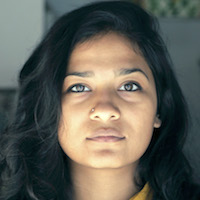
Nishita Jha
Global Women’s Rights Reporter, Buzzfeed News, India
#MeToo has had a very important impact on South Asian newsrooms in a couple of ways: first, it has led to in-house conversations about covering sexual harassment, how to investigate and cover sensitive stories, protect sources and understand the politics of abuse. As a result of this, women journalists know they will be heard if they speak up about experiencing harassment. They are less prone to putting up with abuse as "part of the job".
This is very good news. When I was sexually assaulted by an editor years before I worked at Buzzfeed, much before the MeToo movement, I was told by several senior women reporters that they had faced similar situations but learnt to choose their battles – it was hard enough being a woman covering serious beats, but to acknowledge that they had been victimised sexually would make them seem even more unwelcome in all-male newsrooms.
Informal, flat organisations do not necessarily guarantee that women are safer, but then neither do companies that have anti-sexual harassment policies and cells in place – in India, women journalists applying to some of the country's biggest newspapers are still asked when they plan to marry and start making babies.
It took me a couple of years to understand this: sexual abuse at the workplace is not a battle any one of us is going to win alone. In fact, there's no winning in a situation so awful - a legal route or official route alone cannot provide personal closure, that's for each person to figure out by herself. But each time one of us speaks up and owns her truth, we make it a bit easier for other women to resist. Never forget, courage is contagious.
Busting the boys club

Sara Farid
Freelance photojournalist, Pakistan (living in exile in France)
It is said that journalism is a tough profession but to be a woman journalist, it is a nightmare in a conservative and woman-hostile country like Pakistan.
There are a number of ways harassment occurs: you are felt up, molested and verbally abused. This happens regularly to women in public spaces but it is even more frustrating when this happens while doing your job. A woman walking on the street with a camera spells double trouble. It gives men a reason to invade your personal space. Most of the time you cannot react, as getting into a fight means you are wasting your own time and given deadlines of journalistic assignments, time is precious.
Patriarchy is strongly embedded in our culture and also leads to gender bias in journalism, which is considered to be a man’s world. Sexism is common among editors and reporters and sometimes the grudge is turned into character assassination. I once heard a snarky male editor say, “A woman can never be a 100 per cent journalist. You don’t even need to earn. You have occupied a position of a man who could be feeding his family.” Eleven years ago, I was not as fierce as I am today when I heard this man blatantly telling me that I do not deserve to be in the newsroom.
On one occasion young women in a national Urdu newsroom were advised by senior male colleagues against spending time with us: women who wear sleeveless dresses and have progressive views. “Stay away or you will also go astray like them”.
First, they don’t want you in the newsroom. Once you’ve made your way, they won’t give you the work you want. If you manage to get promoted you are told you must have slept with your boss. When I was not married I was told it’s hard to find a man who will marry a journalist. After I got married, I was told I should not be so selfish and have a child. Once I had my baby, I was repeatedly asked who was taking care of him while I was on assignment. I asked my husband if he was ever asked that. He wasn’t.
Pakistan has seen many women coming into the news industry. But photojournalism or video is still pretty much a boys’ club. Women photographers are a rare breed in Pakistan. Sometimes even subjects ask in surprise, “Are you really a photographer?” Once in Swat valley, while I was covering a Jirga proceeding, a religious leader refused to be photographed by a woman. It is said that it is easier for a woman to access female subjects in places like FATA and Khyber Pakhtunkhwa. But even there, patriarchy blocks our path. During one of my assignments after getting access into a Pashtun family, one of the women told me not to use her photo. “My husband will kill me if my photo gets published.”
The #MeToo campaign is very important for women around the world. In Pakistan, it is not easy to come out and publicly talk about personal experiences of sexual harassment. Women are slut shamed and hardly get support, not even from other women. A woman's story and her intentions are always doubted. All this discourages women and young girls from naming men, especially seniors. This culture of silence needs to be broken.
Not having many women in the profession often made me feel on my own, especially as a freelancer. Becoming a part of the Coalition of Women journalists and being able to mentor other women provided an essential support network.
The discussion has started
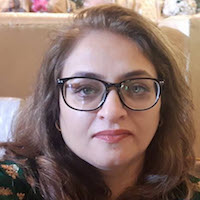
Lubna Jerar Naqvi
Head of Content & Social Media, Jang/Geo Group, Pakistan
Sometimes a bad thing may open up important discussions that didn’t take place due to social and religious customs. This is what happened in Pakistan recently. Sexual harassment was non-existent in our conversations, and most adults including parents avoided any mention of ‘inappropriate’ discussions. Unfortunately, the mega porn scandal in Kasur and rapes and murders of minors made it to the news, followed by an outcry and suddenly sexual harassment, rape and other ‘taboos’ were not only reported in main bulletins but a whole movement seemed to erupt.
Women from different walks of life especially the media began speaking up against sexual harassment they had faced at the hands of colleagues at work, online and outside work. Men have begun to understand that it is not alright to say certain things, to look at a woman in certain ways and to touch.
A couple of years ago I had been invited to speak on sexual harassment on Women’s Day by the provincial government of Sindh. I was jotting down some points and one of my male colleagues inquired what I was doing. When I told him, he laughed and commented that sexual harassment is a ‘figment of women’s imagination’. He said other things that I am sure many working women have heard from people – not only men – around them.
It was infuriating for me to see that many men took sexual harassment so lightly, but working on this for some years has made me aware that this is the type of response you get when you speak about this alien topic – sexual harassment.
Fast forward and now the topics of sexual harassment and rape are openly discussed talked and many men are seen taking interest in this topic and trying to understand the issue from women’s perspective. Women are also talking about it and discussing their encounters or of someone who has been a victim.
This whole scenario has allowed many women in the media to point out people who have been victimising women over the years and it has been noticed in at least one media house that ‘known’ offenders are being isolated and subtly observed by the administration of that organisation. In one case the offender, a senior producer and shift in charge who was known to be a perpetual harasser and also boast about it, was marked by the administration of that organisation. Recently some women made complaints against him and he has been relocated to another department where his interaction with co-workers is restricted. He is under observation and there are indications that strict steps will be taken if and when there is evidence to back the large number of complaints against him.
With many people talking about sexual harassment in the media; among the media people and other places like educational institutions it is hoped that the number of victims will decrease. Or at least women will be able to speak up about it and timely resolution of the issue will take place.
Resilient path breaker
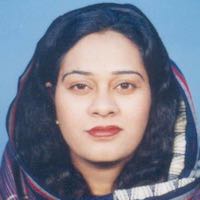
Nadia Sabohi
Correspondent/Producer, Geo TV, Pakistan
Back in 2002, carrying a camera and reporting for a TV channel was the most difficult thing to do in Khyber Pakhtunkhwa in Pakistan’s north western province. Today, 16 years later as the first woman TV journalist in Khyber Pakhtunkhwa I can safely say that if you have a will and faith in your work you can achieve the most difficult things that seemed not only difficult but impossible.
When the people of Khyber Pakhtunkhwa saw a woman reporter walking around roads reporting protests and other events in public spaces where all the other journalists and media personnel were men they found it very hard to accept. In Pakhtun society it is unfathomable that a woman would pick up a camera and actually go out to report: didn’t she know what she was getting into; didn’t she know how dangerous society was for her. But the same woman reporter ignored everyone and went out to report in the field. She wanted to prove that a woman could not only work outside in the field, but was capable of doing the job as well as anyone else. She had the talent to not only do the story from behind the desk but also confidently give beepers in front of the camera and analyse stories and situations on the spot. This was also a new thing considering the magnitude of misogyny in society, where the women remain silent and allow men to give opinions.
A woman reporter has to face a lot of criticism about her work and sometimes this can take on sexual nuances that are quite subtle but everyone involved understands the underlying emotion even if it may be hard to prove. The men in the field made sure that the only woman reporter was made aware that her place was not in the field which was a domain reserved for men. At one time the stories in Khyber Pakhtunkhwa were the worst the country has seen – every other story was of a bloodbath following an act of terrorism. These were difficult stories for any reporter to cover but like the men, the women too learned on the job about how to cope and carry on.
For a society like ours, men do not even have to say much. Their looks, gestures and words are enough to make women feel insecure. They are usually subtle and can go unnoticed if you don’t pay attention, but many men repeat them to make sure the message gets through. And then the physical harassment was another thing all together and quite bad – but it only helped fuel the passion.
Harassment in the relatively conservative society was not very open. But the men made sure to make the woman – the only one among them – feel uneasy because they were uneasy to see her in public spaces. The criticism and harassment may not be openly sexual, but it is an attempt to snatch women’s feeling of achievement. Any award that the women journalist has achieved through sheer hard work is belittled by her male colleagues and looked upon with suspicion. Her own colleagues say that she probably used ‘other means’ to get it because her work was not up to the mark. She is made to feel bad about herself and her work, and a weaker person would probably cave in and quit. But sticking on goes to show that the women journalists of Khyber Pakhtunkhwa are resilient. Amazingly we have more girls as media students from Peshawar University’s Journalism Department willing to take to the field as soon as possible and they say that the women who have paved the way before them are their heroes.
The good news is that the only woman reporter from persevered from 2002 onwards and was so successful in moulding – even if partially – the opinion of the men that now in 2018 there are more women in the field. 15 is a big number compared to the one in 2002.
Towards utopia
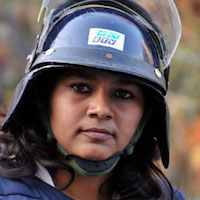
Nadia Sharmeen
Ekattor TV, Bangladesh
In a closed society with rampant victim blaming and entrenched impunity, Bangladeshi media is still struggling even to recognise sexual harassment as a significant problem. So, the #MeToo campaign didn’t work here. Only five female journalists and two female producers had the courage to use this hashtag. But none of them had star value or a visible position that could create a big difference. Being in a patriarchal society, Bangladeshi people have a long way to go to be sensitised about gender equity. Thinking about an abuse free, sexual harassment free society seems almost like a utopia. But women here are still struggling to turn that utopia into reality and have slowly started speaking up against sexual harassment.
A few women are going against society and trying to break the ice. With no support from managements, unions and associations, they are breaking barriers of social stigma on their own. Some media houses are sincere about combating sexual harassment, but their number is very few. And this reaction also depends on the victim’s and accused person’s comparative positions. Men in high positions in the company have a very strong escape route from such accusations. Male counterparts with strong backup power politically, socially and officially are rarely punished. Instead, women media professionals are further victimised after being subjected to sexual harassment and speaking up.
Only three women hold decision-making positions in online media; only two amongst 28 private TV channels and in the print media, that number is only one. So, the redressal mechanisms for complaints of sexual harassment are also male dominated. That makes a victim twice a victim.
So, speaking up against sexual harassment is greatly risky. Women are accused of having vested interests in speaking up and are tagged as ‘bad women’. No journalist union or organisations are so far working consistently to combat sexual harassment. Some, like Bangladesh Nari Shangbadik Kendra arrange small-scale training programs but that is a drop in the ocean. Unions have thus far completely failed to become a pressure group against sexual harassment.
Nowadays, a new trend of sexual harassment has started which is hard for women to deal with: cyber bulling. Two women media professional filed cases against the harasser under the ICT Act. But in the aftermath of those complaints, they are getting more harassed and getting victimised online and offline. After their complaints became public and went viral online, not only their colleagues and bosses, they also faced harassment from outsiders as well. They have had to go through a harrowing legal process and wait for a long time to get the judgment, during which time they faced obstacles in their new job for being so outspoken. Often, women lose their jobs. They also face a great social harassment due to victim blaming. Their characters go through a post-mortem or scanning through a male point of view and they judge the woman as a “bad woman”. Little wonder then that hardly any women complain.
Time to do better
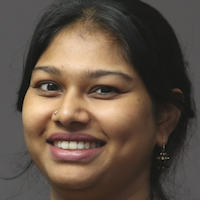
Sharanya Sekaram
Gender activist and editor, bakamoono.lk, Sri Lanka
In October 2017, feminism and social media were set aflame with a single hashtag - #MeToo. Most, if not all adult women have experienced harassment, assault, or abuse in some form. We know this. Didn’t we? Doesn’t the media constantly report cases of gang rape from Jaffna to Tissamaharama? Wasn’t it the media that made us aware that the UNFPA found that 90 per cent of women who travelled on public transport in Sri Lanka said they had been sexually harassed? Isn’t it the media who makes sure that we are aware?
This happens in the media too – both to women (and others) who work in media. Female journalists have shared their own #MeToo stories. Earlier this year I posted a status on my Twitter feed asking women to share their stories of workplace sexual harassment, and several came from women working in the media. The media as a space is not exempt, and we know this.
What we do need to talk about in the light of #MeToo is not just about media as a space, but how media is used as a tool to create the ecosystem in which abuse and harassment thrive. We need to start talking about how the media as a platform and space wields the power to shape our views of women, of their lives, their choices, and the normalisation of such violence. The media need to understand this power comes with great responsibility, and no longer can they avoid this fact.
In March the leading English daily print newspaper in Sri Lanka published an article about a fundamental rights petition using ‘nag’, ‘nitpick’ and ‘lamenting’ to describe the women who filed the petition. This is the same newspaper that regularly accompanies its pieces with salacious cartoons of women, and published a piece that ridiculed a woman who accessed services in a reproductive health clinic; carried articles on rape of young women on ‘gossip’ sites reinforcing victim blaming. The list goes on.
To start is simple, we need to closely examine the stories we choose to give attention and space to, and if we find we are unable to frame them in a way that doesn’t reinforce negative stereotypes or find the public interest benefit of the story, then perhaps we should question why we need to publish it at all. The media plays a crucial role in ensuring that people are viewed as human beings with dignity and rights. They are important allies in helping us combat issues, and show the world that women are people who deserve to be treated and portrayed as such – not as grotesque caricatures in gossip pieces whose aim seems to be to provide cheap entertainment and not much more.
It is now time for every journalist, sub-editor, editor, director, and person working in media and creating content to step up and do better. To be better. Media now needs to be the reason #MeToo becomes the catalyst for change, and not the reason it will continue to exist.
Breaking taboos
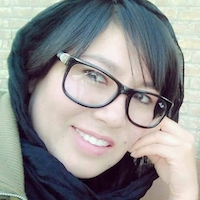
Maryam Mehtar
Afghan news agency Sarienews, Afghansitan
Two years ago, I decided to report on the issue of sexual harassment of women, but everyone refused to work with me. Upon hearing my questions, even a young woman who I had thought was very enlightened, attacked me for thinking she was a whore to be able to talk about such matters. But I have continued to speak out. In December 2017, I gave a frank interview to The New York Times. Here is an excerpt: “You’re ugly, Maryam, everyone says so, but I guess you’re a virgin so when you’re ready to have sex, let me know and I will be glad to…” Her male co-worker, writing on her Facebook account finished obscenely. It was 10 am on a normal day in the life of an Afghan working woman. The journalist Maryam Mehtar, 24, said she had already that morning been harassed or assaulted at least five times: in the bus to work, on the street waiting for the bus, by a man who grabbed her buttocks, by another man who asked how much she charged and by a young boy who said she had a ‘pretty vulva’. Finally, in the relative safety of her own office, she opened her computer to read the Facebook offer from one of her colleagues to deflower her.”
Following my interview in The New York Times and Impact Vice about the harassment of journalists and women at the workplace in Afghanistan, the only response was that some re-published the report on social networks and some appreciated my courage to speak about this issue.
The struggle to survive has made it hard for anyone to be sensitive and care for the lives of others, let alone prosecute someone for persecution of women. Dozens of people are killed every day in the wake of the war in Afghanistan, and people are somehow inured to violence of all kinds. It becomes ‘natural’.
When there is a problem for a woman or girl, there is some activism on social media – by both women and men. However, the excitement of social networks does not last too long. If people sometimes try to organise a demonstration, they are suppressed by the government. When the Hazara community took to the streets on July 23, 2016, the government did not take responsibility for securing the rally, and three large bombs exploded, killing hundreds of people. It is evident that the lives of common people do not count for anything in Afghanistan.
Media houses are expected by law to prevent sexual harassment of women in their offices, but many of them do not have gender policies, making it hard for women journalists to complain. Despite the fact that the media talks about freedom and gender equality, media often abuses women. In the electronic media, women are selected for jobs on the basis of their bodies and appearance and not on the basis of their talent or creativity. Women who do not have a pretty face have no place in the media.
In my opinion, the role of television and some media houses is to perpetuate stereotypes and a negative portrayal of women. There is a recently launched channel, ‘Zan’ (woman), supposed to be aimed at demonstrating women's talent and ability. However, the vacancy announcements for this channel too emphasised only applicants’ looks. How can a women's rights advocate in the media look only for beauty in women?
Resources
- IFJ South Asia Media Bulletin, February 2023 02/15/2023 Download
- IFJ South Asia Media Bulletin, January 2023 01/18/2023 Download
- Nepal Press Freedom report 2022 01/03/2023 Download

